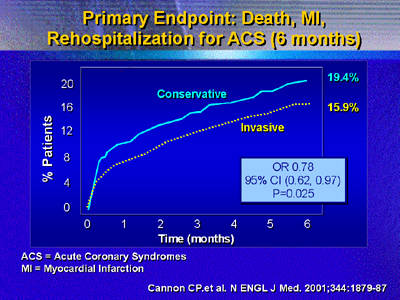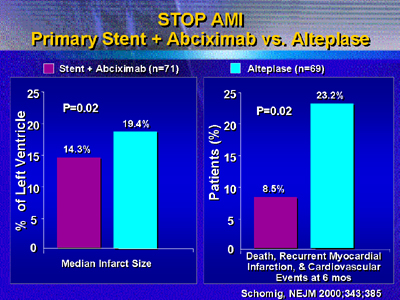| The
advantages and disadvantages of conservative and invasive therapy
were discussed. Recent studies comparing both of these approaches
showed significantly less deaths, myocardial infarctions or rehospitalizations
in patients receiving invasive management. This is due to current
advances in pharmacotherapy and technology. These advances successfully
combine drug therapy with surgery to improve the outcome of acute
coronary disease.
The advantages and disadvantages of conservative or invasive therapy
were discussed. Conservative therapy was defined as medical therapy
such as pharmacological management. Invasive therapy was defined
as interventional therapy such as angiography or stents.
Dr. Cannon explained the history of conservative vs. invasive therapy.
Conservative therapy meant patients received medical therapy with
tissue plasminogen activator, aspirin and heparin and were monitored
for rest ischemia. If ischemia occurred, the patient was referred
for catheterization or a stress test to determine treatment. Invasive
management was either revascularization of the culprit vessel or
cardiac artery bypass surgery. In 1992, data comparing conservative
and invasive management showed no difference in long-term outcome
with either method. As a result, the conservative method became
the method of choice.
Due to recent advances in technology and drug development, more
recent studies have been conducted to determine if one of these
methods may provide a better outcome. The primary endpoint in these
studies was death or myocardial infarction.
Dr. Cannon hypothesized that advances in cardiology would favor
the invasive strategy over the conservative approach. The invasive
approach consisted of routine early catheterization followed by
revascularization based on the anatomy. This was compared to the
conservative strategy of drug therapy. Patients receiving invasive
management showed significantly less number of deaths, myocardial
infarctions or rehospitalizations compared to the conservative strategy.

This is in agreement with other studies that have investigated
these approaches. For example, the Stent versus Thrombolysis for
Occluded Coronary Arteries in Patients with Acute Myocardial Infarction
(STOP AMI) study was conducted in 140 patients. Alteplase was chosen
as pharmacotherapy for the conservative approach. The invasive approach
used a drug along with the invasive therapy: primary stenting and
abciximab. The results indicate significant reduction in myocardial
infarction size, deaths, recurrent myocardial infarctions and cardiovascular
events in the invasive group.

A similar study used aspirin, heparin and balloon angioplasty as
the conservative approach. The invasive approach used stenting and
IIb/IIIa. The results indicate a 50% reduction in myocardial infarction
in patients receiving the invasive strategy. Dr. Cannon concluded
current advances in pharmacotherapy and technology favor an invasive
approach for the treatment of acute coronary disease.
|